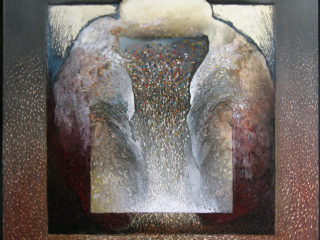
Gleeson, James, Masterpieces of Australian Painting,
Landsdowne Press Pty Ltd, 1969
With Bilu’s paintings the medium and the technique are of primary importance, not because they are ever an end in themselves, but because the way in which the picture is painted is also part of the meaning of the painting. Among Australian painters only Leonard French places a comparable importance on the medium as an integral part of the meaning.
Bilu uses synthetic resins and powdered pigments to build surfaces with a wide variety of eye-beguiling textures. Here and there are signs that fire has tempered the medium, and he often seizes upon the gifts of chance by high-lighting them with fine brushwork. His is a very personal and highly complex technique in which chance clearly plays a creative role – though it does so as servant to a vision and not as a master whose arbitrary acts are final.
Bilu is a visionary. He renders into paint the things that are not of this world – the rapture of the spirit in its struggle towards freedom, the sense of mystery in the joy of birth and becoming, the awe inspired by the majesty of creation.
It helps to understand his art if we think of it as the sort of thing Blake might have done had he lived today and accepted the conventions of abstract art. Bilu’s paintings are visions of cosmic forces expressed in a non-figurative pictorial language – the only pictorial language really capable of communicating a notion of the powers and energies which shape the universe and which animate the spirit.
Maha-Yuga is undoubtedly one of the most mysterious and compelling works in contemporary Australian painting. In it, thousands of particles of matter take shape out of a profound darkness which shrouds the upper part of the painting. Gravity pulls them down in two great streams on either side, but their fall is deflected inwards so that they meet, mingle, gain in vibrancy and colour, and then begin to rise through further zones of darkness and light until the excited particles lose the impulse of direction in the very heart of the painting, where they perform a sort of rapturous dance together. Around them a glowing cloud has formed – a cloud whose shape and texture carries a subtle suggestion of the human brain.
Does it depict the birth of matter? Is it a pictorial diagram showing the birth of an idea? Are the moving particles the primary elements of the material universe or are they the myriad stimuli which feed the brain with sensations and allow us to formulate concepts and notions? One cannot be sure. Its meaning remains equivocal – but it moves us into a new dimension of feeling.
For many, a picture justifies itself if the interplay of colour and form evokes a pleasurable sensation. This attitude is summed up in Maurice Denis’ famous warning: ‘Never forget that in its essence every painting is first of all a picture surface upon which colours are arranged in a particular pattern, and only then is it a warhorse, a nude or some anecdote.’
Even if we do not try to penetrate towards the inner meaning or the secret feeling enshrined in Maha-Yuga it remains a pre-eminently enjoyable fact of painting.
